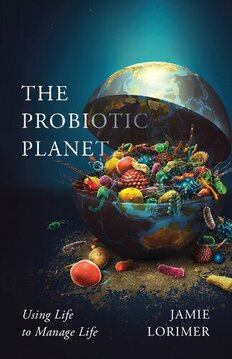
The Probiotic Planet: Using Life to Manage Life PDF
Preview The Probiotic Planet: Using Life to Manage Life
Using Life JAMIE to Manage Life LORIMER the probiotic planet cary wolfe Series Editor 59 The Probiotic Planet: Using Life to Manage Life Jamie Lorimer 58 Individuation in Light of Notions of Form and Information, Volume II: Supplemental Texts Gilbert Simondon 57 Individuation in Light of Notions of Form and Information Gilbert Simondon 56 Thinking Plant Animal Human: Encounters with Communities of Difference David Wood 55 The Elements of Foucault Gregg Lambert 54 Postcinematic Vision: The Coevolution of Moving- Image Media and the Spectator Roger F. Cook 53 Bleak Joys: Aesthetics of Ecology and Impossibility Matthew Fuller and Olga Goriunova 52 Variations on Media Thinking Siegfried Zielinski 51 Aesthesis and Perceptronium: On the Entanglement of Sensation, Cognition, and Matter Alexander Wilson 50 Anthropocene Poetics: Deep Time, Sacrifice Zones, and Extinction David Farrier 49 Metaphysical Experiments: Physics and the Invention of the Universe Bjørn Ekeberg 48 Dialogues on the Human Ape Laurent Dubreuil and Sue Savage-R umbaugh (continued on page 333) posthumanities 42 posthumanities 43 posthumanities 44 posthumanities 45 posthumanities 46 posthumanities 47 posthumanities 48 posthumanities 49 posthumanities 50 posthumanities 51 THE PROBIOTIC PLpostAhumNanitieEs 52T posthumanities 53 Using Life to Manage Life posthumanities 54 posthumanities 55 posthumanities 56 Jpaomsthiuem Lanoitrieism 5e7r posthumanities 58 posthumanities 59 posthumanities 60 posthumanities 61 university of minnesota press minneapolis | london Chapter 3 draws on materials first published in “Probiotic Environmentalities: Rewilding with Wolves and Worms,” Theory, Culture, and Society 34, no. 4 (2017): 27– 48. A version of chapter 5 was first published as “Parasites, Ghosts, and Mutualists: A Relational Geography of Microbes for Global Health,” Transactions of the Institute of British Geographers 42, no. 4 (2017): 544– 58. Chapter 6 draws on elements of Jamie Lorimer and Clemens Driessen, “From ‘Nazi Cows’ to Cosmopolitan ‘Ecological Engineers’: Specifying Rewilding through a History of Heck Cattle,” Annals of the American Association of Geographers 106, no. 3 (2016): 631–5 2. Chapter 6 also draws on elements from Clemens Driessen and Jamie Lorimer, “Back- Breeding the Aurochs: The Heck Brothers, National Socialism, and Imagined Geographies for Nonhuman Lebensraum,” in Hitler’s Geographies: The Spatialities of the Third Reich, ed. P. Giaccaria and C. Minca, 138– 60 (Chicago: University of Chicago Press, 2016). Copyright 2020 by the Regents of the University of Minnesota All rights reserved. No part of this publication may be reproduced, stored in a retrieval system, or transmitted, in any form or by any means, electronic, mechanical, photocopying, recording, or otherwise, without the prior written permission of the publisher. Published by the University of Minnesota Press 111 Third Avenue South, Suite 290 Minneapolis, MN 55401-2 520 http://www.upress.umn.edu Printed in the United States of America on acid- free paper The University of Minnesota is an equal- opportunity educator and employer. 28 27 26 25 24 23 22 21 20 10 9 8 7 6 5 4 3 2 1 Library of Congress Cataloging-in-Publication Data Names: Lorimer, Jamie, author. Title: The probiotic planet : using life to manage life / Jamie Lorimer. Description: Minneapolis : University of Minnesota Press, [2020] | Series: Posthumanities ; 59 | Includes bibliographical references and index. | Identifiers: LCCN 2020020376 (print) | ISBN 978-1-5179-0920-8 (hc) | ISBN 978-1-5179-0921-5 (pb) Subjects: MESH: Probiotics | Environmental Health | Health Behavior | Environmental Microbiology | Public Policy Classification: LCC RA784 (print) | NLM WA 30 | DDC 613.2—dc23 LC record available at https://lccn.loc.gov/2020020376. To Magali, Amelie, and Louis for foraging, fermentation, and unwavering love and friendship contents preface ix introduction Life in the Anthropocene 1 1. The Probiotic Turn: Rewilding and Biome Restoration 25 2. Thinking Like Gaia: The Science of the Probiotic Turn 55 3. Symbiopolitics: Governing through Keystone Species 81 4. Wild Experiments: The Controlled Decontrolling of Ecological Controls 109 5. Geographies of Dysbiosis: The Patchiness of the Probiotic Turn 133 6. Future Pasts: The Temporalities of the Probiotic Turn 161 7. Probiotic Value: Putting Keystone Species to Work 187 conclusions A Spectrum of Probiotics 213 acknowledgments 233 glossary 237 notes 239 bibliography 279 index 323 preface The manuscript of The Probiotic Planet was completed at the end of 2019 and the book was published at the end of 2020. I write this preface in April 2020 in the midst of the global Covid- 19 pandemic. The United King- dom and many other countries are in lockdown. Universities, schools, and most workplaces are closed. Travel and general mobility are tightly restricted, and citizens are social distancing: keeping apart to try to restrict the spread of the disease. The elderly and the already unwell are dying in greater numbers and a profound economic recession is predicted. A general atmosphere of anxiety, uncertainty, and frustration pervades per- sonal and public discourse. One on level, it is an unfortunate time to be publishing a book that maps and encourages a probiotic enthusiasm for microbes and other forms of life. We are living through an amplification of the modern, antibiotic approach to managing life. Hands, surfaces, and volumes of air are awash with antimicrobial chemicals, people are panic- buying per- sonal protective equipment to secure their lungs and bodies, and the pressures for distancing and isolation enact boundaries and territories around bodies, homes, and nations. Resources are dedicated to antiviral drugs and vaccines to accelerate the development of immunity. Such a response is understandable, for Covid- 19 is a new and lethal pathogen that we must make time to tame and live with. But as the pandemic hopefully eases and we come to better under- stand how it emerged and spread, how it was known and experienced, and how such pandemics might be averted in the future, I wager that we might benefit from the types of probiotic thinking and action that are mapped in this book. A probiotic approach involves using life to manage ix
